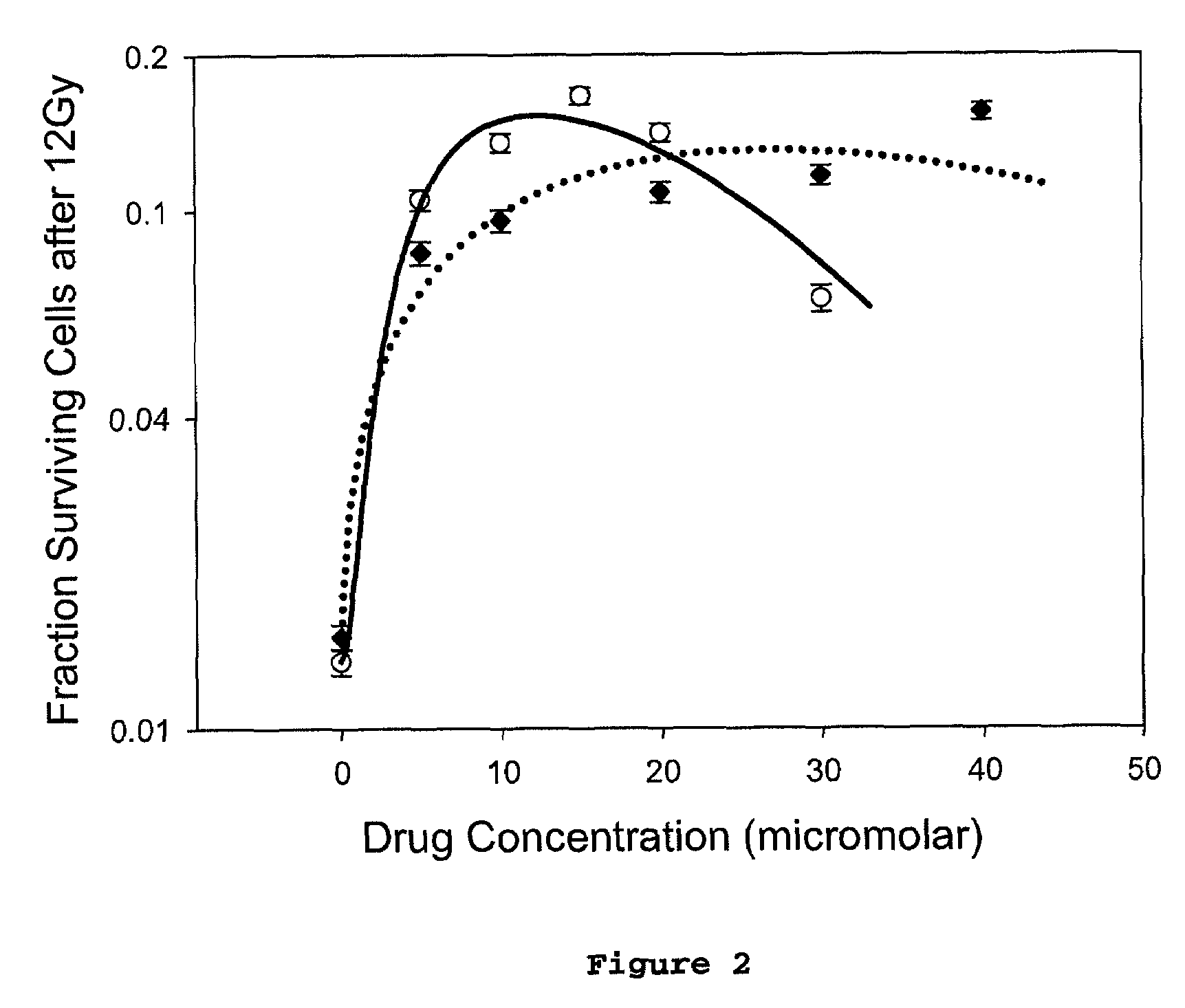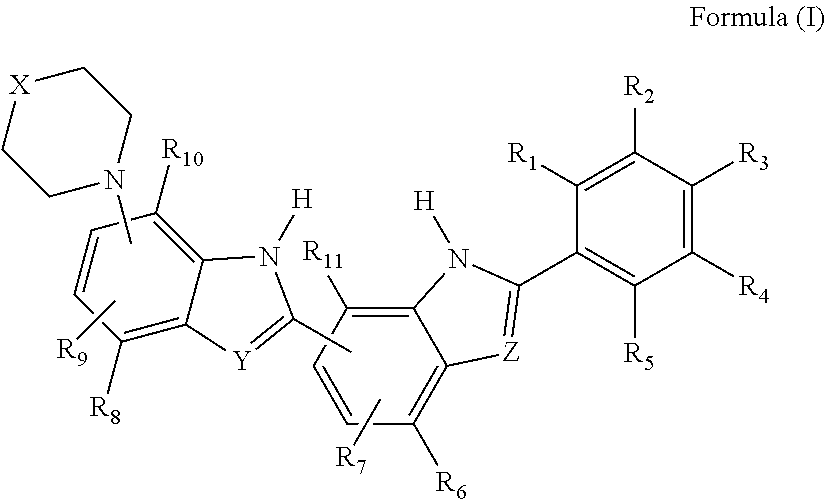Radioprotector compounds and related methods
a technology of radiation protection compound and radioprotector, which is applied in the field of radiation protection compound, can solve the problems of ionising radiation inducing damage in dna base, lethal to organisms, temporary or permanent impairment of tissue and organ function, etc., and achieves the effect of reducing radiation damage in biological materials and minimizing damage to non-tumour cells
- Summary
- Abstract
- Description
- Claims
- Application Information
AI Technical Summary
Benefits of technology
Problems solved by technology
Method used
Image
Examples
example 1
Preparation of 4-dimethylamino-2-fluoro-1-(5′-(5″-(4′″-methylpiperazin-1′″-yl)benzimidazol-2″-yl)benzimidazol-2′-yl)benzene (1)
[0134]To a solution of 4-dimethylamino-2-fluorobenzaldehyde (i) (1.98 g, 11.8 mmol) in ethanol (35 ml) was added a solution of sodium metabisulfite (2.6 g, 13.7 mmol) in 1:1 ethanol / water (40 ml) and the mixture was warmed for 10 min. A solution of diamine (PH) (from catalytic hydrogenation of 3.22 g of nitroamine (PO), 9.14 mmol) in ethanol (50 ml) was then added and the mixture was refluxed under nitrogen for 21 h. The condenser was then replaced with a stillhead and approx 50 ml of reaction solvent was removed by distillation. The remaining reaction mixture was then cooled to −20° and the yellow solid was collected and carefully washed with dilute ammonia solution (6%, 50 ml), water (50 ml), acetone (2×20 ml) and ether (50 ml) before being dried under vacuum to give 4-dimethylamino-2-fluoro-1-(5′-(5″-(4′″-methylpiperazin-1′″-yl)benzimidazol-2″-yl)benzimid...
example 2
Preparation of 2,6-difluoro-4-dimethylamino-1-(5′-(5″-(4′″-methylpiperazin-1′″-yl)benzimidazol-2″-yl)benzimidazol-2′-yl)benzene (2)
[0136]A solution of 2,6-difluoro-4-dimethylaminobenzaldehyde (ii) (0.20 g, 1.1 mmol) in ethanol (10 ml) was treated with a solution of sodium metabisulfite (0.246 g, 1.3 mmol) in water (1 ml), and the combined mixture was then added to a solution of the diamine (PH) (0.29 g, 0.9 mmol) in ethanol (14 ml), and was refluxed under nitrogen for 24 h. The reaction mixture was cooled, the solvents removed by rotary evaporator and the residue was treated with dilute ammonia solution (6%, 2×20 ml), acetonitrile (2×20 ml) and ether (2×20 ml) with each treatment followed by centrifugation and removal of the supernatant. Drying of the resultant solid under vacuum afforded 2,6-difluoro-4-dimethylamino-1-(5′-(5″-(4′″-methylpiperazin-1′″-yl)benzimidazol-2″-yl)benzimidazol-2′-yl)benzene (2) as a light tan powder (0.362 g, 82%), mp 259-261°.
[0137]1H nmr (500 MHz, d4-MeOH...
example 3
Preparation of 2-fluoro-4-methylamino-1-(5′-(5″-(4′″-methylpiperazin-1′″-yl)benzimidazol-2″-yl)benzimidazol-2′-yl)benzene (3)
[0138]A solution of 2-fluoro-4-methylaminobenzaldehyde (iii) (0.10 g, 0.65 mmol) in ethanol (10 ml) was treated with a solution of sodium metabisulfite (0.15 g, 0.8 mmol) in water (5 ml) and the mixture was heated gently for 10 min. A solution of the diamine (PH) (0.16 g, 0.5 mmol) in ethanol (16 ml) was added and the mixture was refluxed under nitrogen for 21.5 h. The reaction mixture was cooled, filtered, and the filtered solid was washed with dilute ammonia solution (6%, 2×10 ml), acetone (2×10 ml), ether (2×10 ml), then dried under vacuum to give 2-fluoro-4-methylamino-1-(5′-(5″-(4′″-methylpiperazin-1′″-yl)benzimidazol-2″-yl)benzimidazol-2′-yl)benzene (3) as a tan powder (0.165 g, 73%).
[0139]1H nmr (500 MHz, d4-MeOH+3 drops d-TFA) δ 2.91, s, 3H, 4-MeN; 3.01, s, 3H, 4′″-MeN; 3.20, t (J=12 Hz), 2H, NCH2; 3.34, m (obscured), NCH2; 3.69, d (J=11 Hz), 2H, NCH2;...
PUM
| Property | Measurement | Unit |
|---|---|---|
| time | aaaaa | aaaaa |
| time | aaaaa | aaaaa |
| body weight | aaaaa | aaaaa |
Abstract
Description
Claims
Application Information
 Login to View More
Login to View More - R&D
- Intellectual Property
- Life Sciences
- Materials
- Tech Scout
- Unparalleled Data Quality
- Higher Quality Content
- 60% Fewer Hallucinations
Browse by: Latest US Patents, China's latest patents, Technical Efficacy Thesaurus, Application Domain, Technology Topic, Popular Technical Reports.
© 2025 PatSnap. All rights reserved.Legal|Privacy policy|Modern Slavery Act Transparency Statement|Sitemap|About US| Contact US: help@patsnap.com



